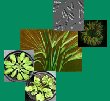| Peters, W; Ritter, J; Tiller, H; Valdes, O; Renner, U; Fountain, M; Beck, E: Growth, ageing and death of a photoautotrophic plant cell culture, Planta, 210, 478-487 (2000), doi:10.1007/PL00008155 | |
| Abstract: Batch cultures of photoautotrophic cell suspensions of Chenopodiumrubrum L., growing in an inorganic medium on CO2 under a daily balanced light–dark regime of 16 : 8 h could be maintained for approximately 100 d without subcultivation. The long-lived cultures showed an initial cell division phase of 4 weeks, followed by a stationary phase of another 4 weeks, after which ageing and progressive cell death reduced the number of living cells and the cultures usually expired after another 3–4 weeks. These developmental phases of the cell culture were characterised with respect to photosynthetic performance, dark respiration, content of phytohormones and capacity of cell division. Cell division of the majority of the cells finished in the G1- or G0-phase of the cell cycle, caused by a pronounced decline in the endogenous levels of auxin and cytokinins. Supply of these growth factors to resting cells resulted in resumption of cytokinesis, at least by some of the cells. However, responsiveness to the phytohomones declined during the stationary phase, and subcultivation was no longer possible beyond day 60 when the phases of ageing and death commenced. Ageing was characterised by a further decline in the photosynthetic capacity of the cells, by a climacteric enhancement of dark respiration, but also by a slight increase in the level of IAA and cytokinins concomitant with a decrease in ethylene. Similarities and differences between the development of batch-cultured photoautotrophic cells of C. rubrum and that of a leaf are discussed with respect to using the cell culture as a model for a leaf. |

Letzte Änderung 09.06.2020

